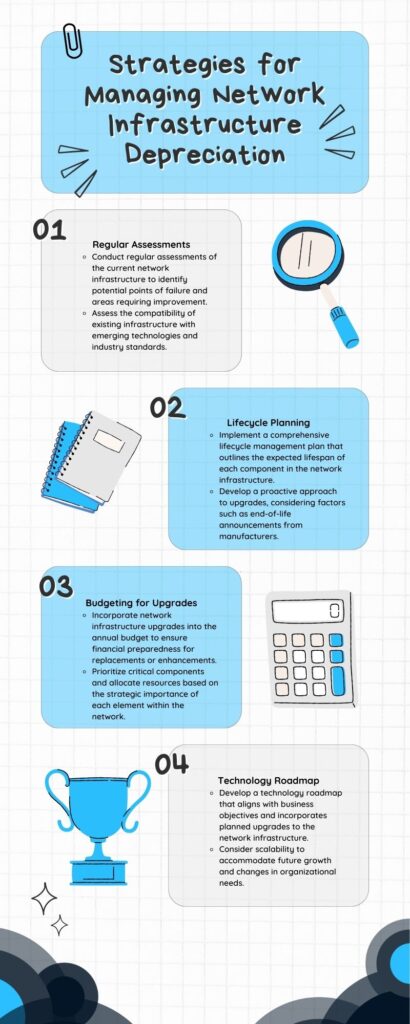Internet Service Providers rely on robust network infrastructure to ensure seamless operations and stay competitive. As these infrastructures age, managing depreciation becomes an important aspect of financial planning and resource allocation. This blog explores the importance of managing depreciation for network infrastructure and provides strategies for ISPs.
Understanding Network Infrastructure Depreciation
Network infrastructure encompasses the hardware, software, and protocols that enable communication and data exchange within an organization. Over time, these components experience wear and tear, technological obsolescence, and evolving security requirements, leading to a decline in their value. Depreciation is a systematic allocation of the cost of these assets over their useful life, reflecting their decreasing value on the balance sheet.
Key Factors Influencing Network Infrastructure Depreciation
Technological Advancements
The rapid pace of technological advancements in networking equipment can result in the obsolescence of existing infrastructure. Staying ahead of industry trends is vital to identifying when upgrades are necessary.
Security Considerations
As cyber threats continue to evolve, network infrastructure must adapt to new security standards. Outdated equipment may pose significant risks, making timely upgrades essential for maintaining a secure digital environment.
Maintenance Costs
Aging network components often incur higher maintenance costs. Monitoring these costs against the potential benefits of upgrading helps in determining the optimal time for replacements or enhancements.
Strategies for Managing Network Infrastructure Depreciation

Regular Assessments
-
- Conduct regular assessments of the current network infrastructure to identify potential points of failure and areas requiring improvement.
- Assess the compatibility of existing infrastructure with emerging technologies and industry standards.
Lifecycle Planning
-
- Implement a comprehensive lifecycle management plan that outlines the expected lifespan of each component in the network infrastructure.
- Develop a proactive approach to upgrades, considering factors such as end-of-life announcements from manufacturers.
Budgeting for Upgrades
-
- Incorporate network infrastructure upgrades into the annual budget to ensure financial preparedness for replacements or enhancements.
- Prioritize critical components and allocate resources based on the strategic importance of each element within the network.
Technology Roadmap
-
- Develop a technology roadmap that aligns with business objectives and incorporates planned upgrades to the network infrastructure.
- Consider scalability to accommodate future growth and changes in organizational needs.
Vendor Relationships
-
- Establish strong relationships with technology and equipment vendors to stay informed about upcoming releases and product roadmaps.
- Leverage vendor support and maintenance agreements to optimize the performance and longevity of network infrastructure.
Final Thoughts
Managing depreciation for network infrastructure is an important aspect of maintaining a secure, efficient, and competitive business environment. By adopting a proactive approach to lifecycle planning, budgeting, and vendor relationships, Internet Service Providers can navigate the complexities of network infrastructure depreciation with confidence, ensuring their digital foundations remain robust and resilient in the face of constant change.




